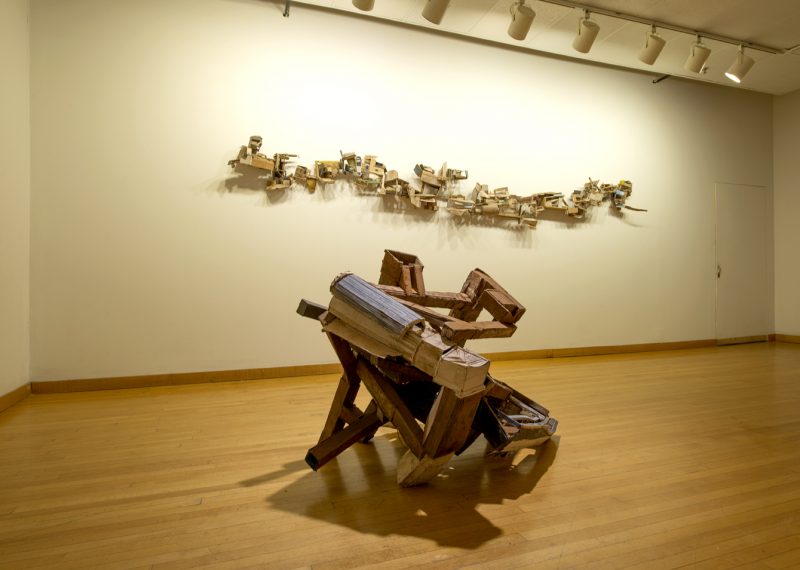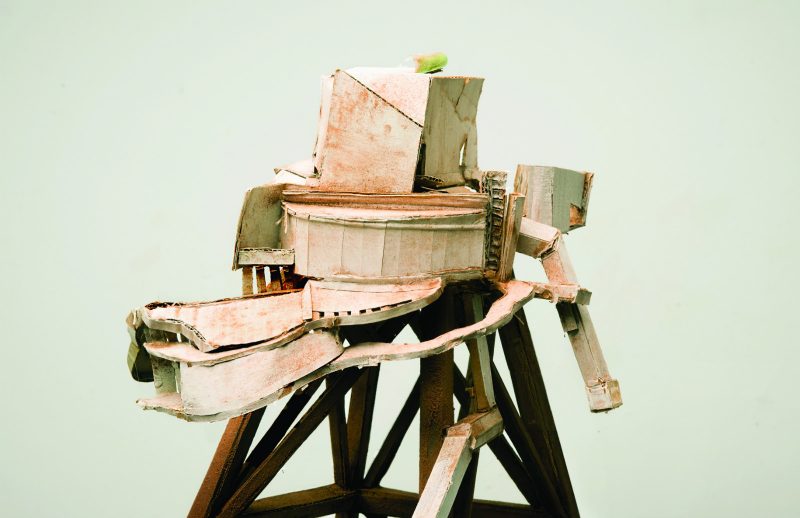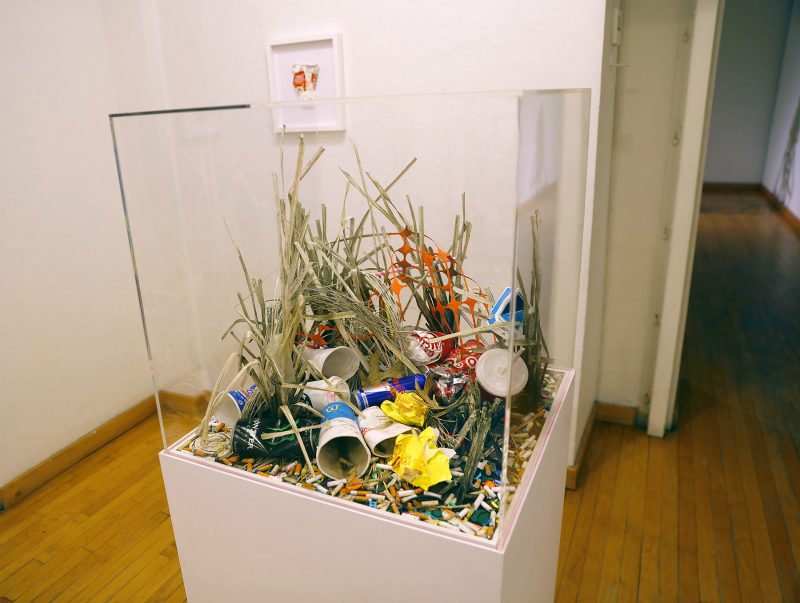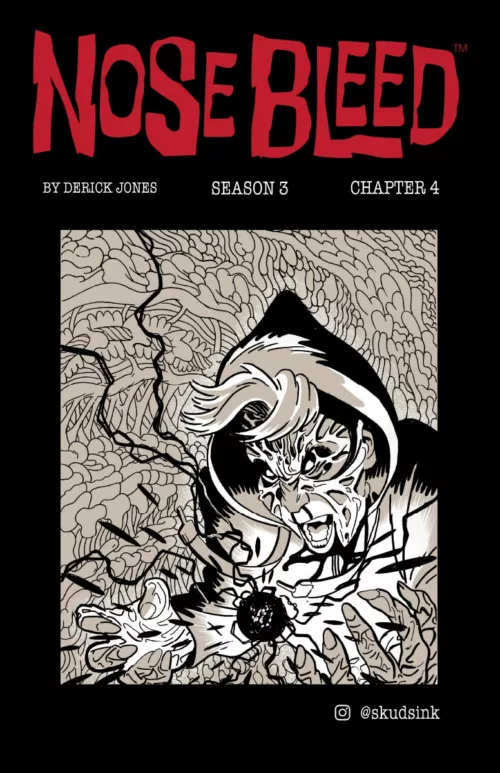The works of emerging/mid career artists Amber Johnston, Brian Richmond, and Michelle Marcuse in the current Wind Challenge Exhibition at the Fleisher Art Memorial represent a small sampling by these notable Philadelphia artists. But a sense of their chosen direction is evident. This may not be the strongest Challenge show ever, taking into consideration it is the 39th year, but there is much fodder for discussion and at the opening the air was buzzing with questions and commentary about these three distinct personal narratives.

Found objects, childhood memories
Having found her voice as a sculptor–after many years of working in encaustic painting–Michelle Marcuse builds on a modernist paradigm of the found object, while hedging on global issues of repurposing and recycling materials. In her case, she makes use of discarded cardboard.
The artist revealed during her artist talk at the exhibit’s opening reception that her early childhood memories were source material for the drawings and three sculptures on display. The structures, seen in the round and suspended on the wall made exclusively of cardboard, are crudely constructed, alluding to the source of her inspiration–Johannesburg shantytowns. The artist intimated that as a child she felt like a voyeur into a world she did not completely understand. Now, the images of these towns loom large in Marcuse’s psyche and represent the inequity of existence in apartheid South Africa that separated whites, blacks, and coloreds. After a gestation period of decades, Marcuse in her past and current work traverses psychoanalytic landscapes of dreams and memories.

As a mature artist, Marcuse plays with formal elements of composition; however, she seems to invite close scrutiny of the rough-hewn quality of the construction, even emphasizing that aspect. On viewing Marcuse’s “Signs of Compromise” (2016), these two art world masterworks come to mind: Duchamp’s “The Bride Stripped Bare by Her Bachelors, Even” (1915-1923) and Vladimir Tatlin’s tower, “Monument to the Third International” (1920). To say Marcuse’s work hearkens back to another era is not a bad thing–after all, these are titans in the annals of art history. She has found a material that transcends its humble origin in an attempt to create works that are substantial and nuanced and that move toward the monumental. Marcuse is definitely onto something that greatly expands her visual vocabulary!
Digital mug shots
Amber Johnston explores the use of the cell phone to capture candid and slightly unnerving headshots of a diverse group of people. The artist uses the mug shot with a twist in her installation “Digital Connection” (2016). Her streamed video images of close-cropped headshots are nearly motionless except for the blinking gaze of her subjects, who look directly into the camera.
The premise of Johnston’s installation is based on the use of the iPhone, and issues of alienation and isolation are broached related to this mediating communication device. Without this background information, I don’t think you would know the role the cell phone played in the creation of the piece or if love is in fact conveyed through the gaze of Johnston’s sitters. Evidently, she asked each subject to look as if they were staring into the eyes of someone they loved.
The mug shot is an approach in photography that dominates the contemporary art scene; this crisp clean format is a favorite of artists from Chuck Close to Jefferson Pinder. Also it serves as a cinematic tool to build an affinity between the audience and key characters, I suppose. Although I felt Johnston’s approach was not unique–what is these days?–the installation held together well. Set against white backgrounds, the portrayal of this ethnically diverse group is refreshing, if one can read into the display a commentary on multiculturalism or a global purview. It is infrequent for artists to be so cognizant as to include black and brown people in their work without having a specific agenda related to race and politics.

Meticulous dioramas
Brian Richmond pays homage to an ecologically conscious theme. Richmond’s trompe l’oeil dioramas of debris are very convincing. When one is informed that each element in the dioramas are all meticulously painted by hand, from cigarette butts to crushed soda cans, a eureka moment is experienced. Noting the debris that litters our roadways, beaches, and wetlands, he painstakingly paints the residue of human carelessness–soda and beer cans, cigarette butts, and assorted paper wrappers from picnic leftovers found across these landscapes. His small-scale dioramas made of sculpted paper and resin, and painted with acrylic are carefully encased and are reminiscent of beach fronts replete with tufts of marsh grass.

At first sight, the viewer may be slightly amused in seeing art devoted to hyper real renditions of trash, but after deep consideration his commentary is poignant and timely. Campaigns across the country are waged to raise consciousness about the disposal of trash; of note locally right now is a video installation by George Lewis on display at the ICA, which focuses on a waste maintenance facility and the sounds emitted from this environment. We are a society that brands everything, and each item except the faux foliage in Richmond’s dioramas sports labels (Coors, Marlboro, Target, Wendys); we discard, often carelessly, the materials we use and consume.
A great experiment, the Samuel Fleisher Art Memorial has for 118 years promoted making art accessible for all regardless of class, economic means, or artistic acumen. The Wind Challenge Exhibition, in its 39th year, is off to a grand start with the current iteration of the administration under the leadership of Elizabeth Grimaldi. However, let’s not forget the innumerable artists who have graced the walls of the Fleisher Art Memorial, from Bo Bartlett to Virgil Marti, who have continued to make exceptional art. Johnston, Richmond, and Marcuse join an illustrious group of artists who have contributed to Philadelphia’s cultural history.









